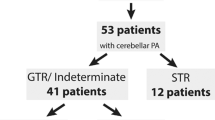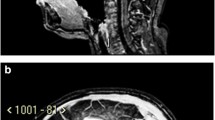Summary
Background. The long-term prognosis for incompletely excised benign cerebellar astrocytomas in children remains largely unpredictable as the incidence of symptomatic recurrence ranges from 18 to 100%. Arrested growth and spontaneous tumour regression are a recognized but neglected phenomenon, the incidence and objective demonstration of which have received relatively little attention in the literature. With the aim of providing more information on this question, we reviewed our experience with incompletely resected benign cerebellar astrocytomas in children.
Clinical material and methods. Our series consisted of 31 children with long-term follow-up. None had signs of type 1 neurofibromatosis (NF1). Histology included 22 classic pilocytic and nine diffuse astrocytomas. Seventeen children had symptomatic recurrence after 25 to 450 months and fourteen children remained in good health for 84 to 516 months.
In looking for evident clinical differences that could help elucidate the different courses, we also examined recent radiographic images to assess tumour status. The literature was reviewed to obtain further information on nonrecurring and on regressing cerebellar astrocytomas after partial resection in the setting of modern surveillance imaging resources.
Findings. No differences in factors that could elucidate the different clinical courses were found between the two groups of children. Recent negative CT scans or NMR images were reported in seven cases. In two cases arrested growth or regression of a previously visible neoplastic remnant was noted. Review of the literature showed that radiographic follow-up has revealed arrested growth or spontaneous regression of benign cerebellar astrocytoma remnants in 32.5% and 14% of cases, respectively.
Conclusions. As hypothesized by Cushing, our study shows that a large proportion of cerebellar astrocytomas do not progress or even regress after partial excision. This phenomen is not understood and unfortunately cannot be anticipated. However, it suggests that a policy of “wait and see” with serial MR imaging can reasonably be recommended in children with cerebellar astrocytoma after partial resection, if the remnant is too risky to be removed by second-look surgery.
Similar content being viewed by others
Author information
Authors and Affiliations
Rights and permissions
About this article
Cite this article
Palma, L., Celli, P. & Mariottini, A. Long-term follow-up of childhood cerebellar astrocytomas after incomplete resection with particular reference to arrested growth or spontaneous tumour regression. Acta Neurochir 146, 581–588 (2004). https://doi.org/10.1007/s00701-004-0257-9
Published:
Issue Date:
DOI: https://doi.org/10.1007/s00701-004-0257-9




